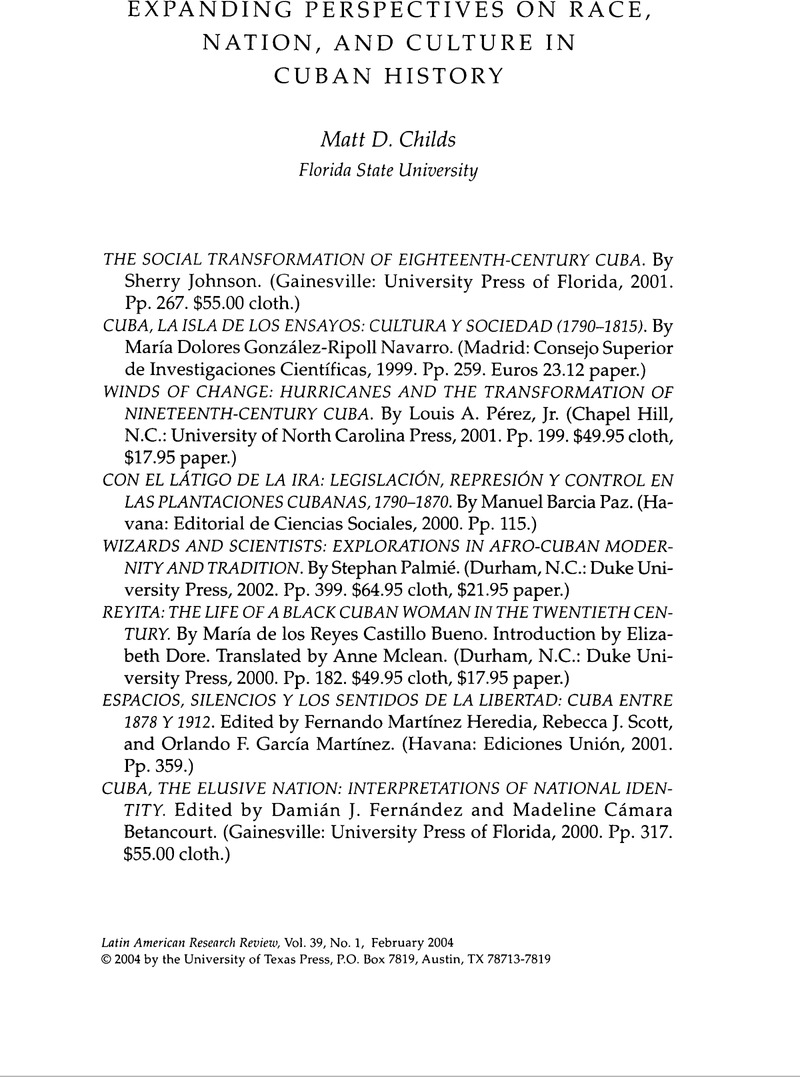Article contents
Expanding Perspectives on Race, Nation, and Culture in Cuban History
Review products
Published online by Cambridge University Press: 05 October 2022
Abstract

- Type
- Review Essays
- Information
- Copyright
- Copyright © 2004 by the University of Texas Press
References
1. For a review of some of the most recent literature on Cuba in the 1990s, see Michael Snodgrass, “Assessing Everyday Life in Post-Soviet Cuba,” LARR 36, no. 3 (2001): 204–20.
2. Alejandro de la Fuente also points to the crisis in the 1990s for the recent attention to race and racism in Cuban Studies, “Race, Ideology, and Culture in Cuba: Recent Scholarship,” LARR 35, no. 3, (2000): 199–210.
3. Louis A. Pérez, Jr., “History, Historiography, and Cuban Studies: Thirty Years Later,” in Cuba Studies Since the Revolution, ed. Damián Fernández, (Gainesville: University Press of Florida, 1992), 53.
4. For a description of one program see, Alejandro de la Fuente, “Teaching History in Cuba,” LASA Forum 30, no. 3 (1999): 12–13.
5. Allan J. Kuethe, Cuba, 1753–1815: Crown, Military, and Society, (Knoxville: University of Tennessee Press, 1986).
6. Philip A. Howard, Changing History: Afro-Cuban Cabildos and the Societies of Color in the Nineteenth Century (Baton Rouge: Louisiana State University Press, 1998), 31–36.
7. For an interesting analysis of the wreck of the Sea Venture that provided the historical material for Shakespeare's The Tempest, see Peter Linebaugh and David Rediker, The Many-Headed Hydra: The Hidden History of the Revolutionary Atlantic (Boston: Beacon Press, 2000), 8–35.
8. See Fernando Ortiz, Los negros brujos (1906, Reprint; Havana: Editorial de Ciencias Sociales, 1995); Idem., Los negros esclavos (1916, Reprint; Havana: Editorial de Ciencias Sociales, 1975).
9. Frank Tannenbaum, Slave & Citizen: The Negro in the Americas (New York: Vintage, 1946); Stanley M. Elkins, Slavery: A Problem in American Institutional and Intellectual Life (Chicago: University of Chicago Press, 1959), 63–80; and Herbert S. Klein, Slavery in the Americas: A Comparative Study of Virginia and Cuba (Chicago: University of Chicago Press, 1967), 77–85.
10. Franklin Knight, Slave Society in Cuba During the Nineteenth Century (Madison: University of Wisconsin Press, 1970), 36; and Gwendolyn Midlo Hall, Social Control in Slave Plantations Societies: A Comparison of St. Domingue and Cuba (Baltimore, Md.: Johns Hopkins University Press, 1971), 111–12.
11. While not focusing exclusively on the slave laws, both Howard, Changing History, 3–4, 125–26, 187–88, and Robert L. Paquette, Sugar is Made With Blood: The Conspiracy of La Escalera and the Conflict Between Empires over Slavery in Cuba (Middletown, Conn.: Wesleyan University Press, 1988), 77–80, 231–32, 267–74, provide important insights that show the discrepancy between the law and practice.
12. De la Fuente, “Race, Ideology, and Culture in Cuba,” 199.
13. José Luciano Franco, Las conspiraciones de 1810 y 1812 (Havana: Editorial de Ciencias Sociales, 1977).
14. José Luciano Franco, La conspiración de Aponte (Havana: Publicaciones del Archivo Nacional, 1963), 20–21.
15. Miguel Barnet, Biografía de un cimarrón (1963, Reprint; Havana: Editorial Academia, 1996).
16. Michael Zueske, “The Cimarrón in the Archives: A Re-Reading of Miguel Barnet's Biography of Esteban Montejo,” New West Indian Guide 71, nos. 3–4 (1997): 265–79.
17. Aline Helg, Our Rightful Share: The Afro-Cuba Struggle for Equality, 1886–1912 (Chapel Hill, N.C.: University of North Carolina Press, 1995).
18. Ada Ferrer, Insurgent Cuba: Race, Nation, and Revolution, 1868–1898 (Chapel Hill, N.C.: University of North Carolina Press, 1999).
19. Louis A Pérez, Jr., On Becoming Cuban: Identity, Nationality, & Culture (New York: HarperCollins, 1999).
20. Robin Moore, Nationalizing Blackness: Afrocubanismo and Artistic Revolution in Havana, 1920 to 1940 (Pittsburgh: Pittsburgh University Press, 1997).
21. Alejandro de la Fuente, A Nation for All: Race, Inequality, and Politics in Twentieth-Century Cuba (Chapel Hill, N.C.: University of North Carolina Press, 2001).
22. K. Lynn Stoner, “Recent Literature on Cuba and the United States,” LARR 31, no. 3 (1996): 240.
23. For some of the recent work done by the latest generation of Cuban historians see, José A Piqueras Arenas, ed., Diez nuevas miradas de historia de Cuba (Castelló de la Plana: Publicacions de la Universitat Jaume I, 1998).
- 4
- Cited by




